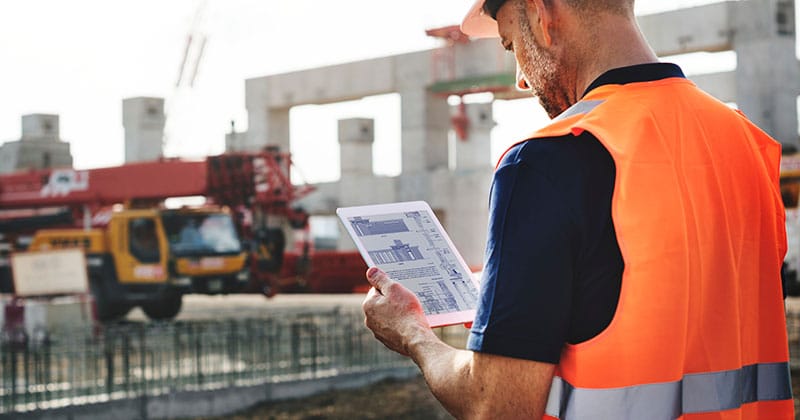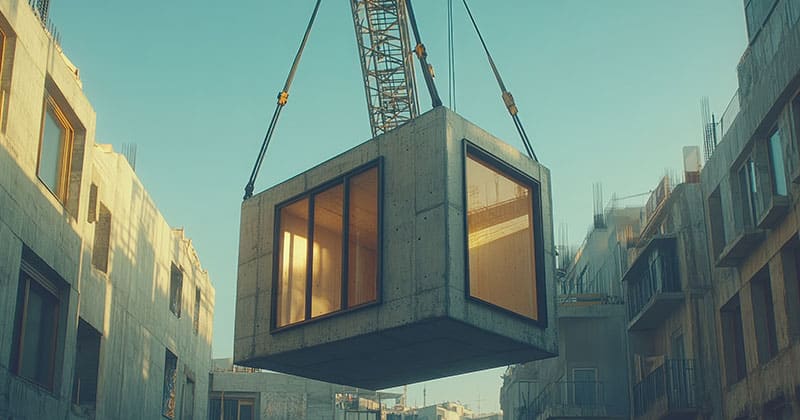8 Construction Industry Trends in 2025 and Beyond
It’s always better to be in the know when it comes to industry trends. Let’s break down the most pressing topics in construction for 2025 and talk about how you can stay ahead.

Managing Editor
The construction industry is evolving rapidly. And if you’re a small-to-medium-sized home service provider, now’s the time to pay attention.
The trends shaping the industry in 2025 and beyond will directly impact companies of all sizes. This goes for your operations, revenue, and long-term sustainability.
Why does this matter? Because change is coming fast. From labor shortages to digital transformation, understanding what’s ahead gives you an advantage. It allows you to make smarter decisions and stay competitive. And ultimately, it empowers you to build a strong business.
But in this article, we’re not just listing trends. We’re diving deep into what’s changing, why it matters, and what you can do about it.
Let’s explore the key construction industry trends that will define its future and give you practical ways to stay ahead!
The Biggest Construction Industry Trends in 2025 and Beyond
Construction is becoming more data-driven, tech-forward, and sustainability-focused. That much is clear and inevitable.
These insights are agreed upon by top businesses and sources across the industry. So, you’ll want to make sure you’re on top of them, too—let’s dig in.
1. Managing the Labor Mismatch
The construction labor market is facing a significant imbalance. In 2024, the U.S. industry needed more than 500,000 additional workers to keep pace with demand. This shortage is projected to persist into 2025 and beyond.
One of the core challenges is the aging workforce. Unfortunately, young people are just not interested in the construction industry. On top of that, many of the existing seasoned professionals are retiring. The median age of a construction worker in the U.S. is now over 42. That’s above the national average for all industries.
Simultaneously, newer construction techniques require a different skillset. For example, the use of advanced materials or integrated tech platforms. This makes it even harder to fill open roles quickly.
A recent survey found that 94% of construction firms are struggling to fill positions. That’s not just an inconvenience. It’s lost revenue, increased customer frustration, and pressure on existing staff.
To address the labor mismatch, here are several strategies your company can adopt:
- Employ AI-powered workforce management tools. These can help predict scheduling needs, identify gaps, and improve resource allocation.
- Some firms are creating apprenticeships and partnering with local vocational schools.
- Others have successfully hired veterans and former automotive techs by offering upskilling opportunities. This is a good reminder that talent can come from non-traditional places.

2. Technological Advancement and Digitization
The construction industry has traditionally been slow to innovate. However, recent years have brought a wave of digital evolution. In a McKinsey survey, 77% of respondents planned to invest more in AEC (architecture, engineering, and construction) tech over the next several years.
Digital tools are now a standard part of competitive construction operations. And they play a part in everything from pre-construction planning to field execution.
For example, technologies like Building Information Modeling (BIM) allow contractors and designers to create highly detailed 3D models. These models integrate with architectural, structural, and MEP systems, yielding many benefits, like:
- Minimizing on-site errors
- Informing material choices and schedules
- Reducing safety and sustainability risks
- Keeping budgets on track
- Boosting coordination across teams
These digital twins—virtual replicas of physical buildings—are being used beyond design. They can be useful throughout a building’s lifecycle. With IoT sensors feeding real-time data into these twins, teams can anticipate maintenance needs and optimize energy usage.
Digitization also extends to client communication.
Firms are using online portals to share real-time timelines, budgets, and updates. This has dramatically improved transparency and client satisfaction. Especially in residential construction, where homeowners want to stay informed, these tools can make a company stand out.
And then there’s data. With analytics platforms, companies have become much more efficient. You can now forecast project risks and analyze subcontractor performance. Some tools can even predict equipment breakdowns before they happen. These insights can lead to significant cost savings and better outcomes.
In 2025 and beyond, embracing emerging digital construction technologies is critical. These tools will be crucial for driving operational efficiency and supporting project delivery. Adopting these technologies is becoming the industry standard.
3. Robotics and Automation
Automation is fast becoming a game-changer in construction. And it’s not just in mega-projects.
Drones are increasingly used on homebuilding sites. They can conduct aerial surveys, monitor job site progress, and track inventory. Drone tech is also being used for automated inspections—after hailstorms, for example. This can cut inspection costs and time and reduce liability risks for workers.
Robotics are also being used for repetitive tasks such as bricklaying, concrete dispensing, and even painting.
A 2023 ABB survey found that 55% of construction companies already use some form of robotics. Moreover, 81% plan to expand their use in the next decade. Robotics are here, and they are here to stay.
3D printing is also moving from novelty to utility. In Austin, Texas, ICON has printed entire neighborhoods using massive 3D printers. The result? Affordable housing solutions with faster build times and reduced labor needs.
Of course, this is a large-scale example. And larger construction firms have the advantage of access to these tools. But it’s still something to keep an eye on as robotics and technologies become more and more accessible.
These innovations aren’t replacing workers, though—they’re supporting them. Automation tools enhance precision, improve job site safety, and allow skilled workers to focus on higher-level tasks.
4. The Role of AI In Construction
AI is poised to revolutionize nearly every corner of the world. The construction industry is no exception.
AI is transforming construction work in many ways, such as:
- Reshaping traditional workflows
- Offering predictive insights
- Enabling advanced design innovation
- Helping parse complex construction schedules
In project management, AI can even forecast potential delays. It does this by analyzing weather patterns, supply chain data, and workforce availability.
AI tools can process thousands of design permutations. This allows them to suggest the most cost-effective and structurally sound options. Tools like Autodesk’s generative design software are already being used this way. For example, to create layouts that maximize usable space while reducing material waste.
Safety is another domain seeing rapid improvements through AI. Smart cameras with machine learning can detect and alert you to unsafe behaviors. AI could alert site supervisors in real time if workers are not wearing PPE, for instance.
AI is even improving customer communication. Chatbots and AI-driven portals help clients track their project progress and answer FAQs. Some can even help streamline material selections. This saves office staff dozens of hours each month.
Here are some examples of some construction-specific AI tools being used right now:
- Autodesk Construction Cloud
- Procure
- BuildXAct
- Dzinly
- Digs
- OpenSpace
- ALICE
- Adobe Firefly
As new tools continue to emerge, AI in construction will become a competitive necessity.
5. Sustainable and Green Building Practices
Sustainability has shifted from a nice-to-have to a must-have.
According to PwC’s Digital Trends Survey, there’s a growing executive focus on sustainable practices. more than half of operations and supply chain executives now say that incorporating sustainability into operations is becoming more important. This aligns with public opinion, too. There’s a higher demand for eco-conscious homes. Additionally, there has been increasing regulatory pressure to reduce carbon footprints.
Homeowners are asking more questions that indicate a focus on sustainability, too. They’ve shown interest in energy efficiency and smart technology.
Living building materials are becoming more mainstream. Examples include self-healing concrete and Biomason’s bio-based bricks. These materials reduce environmental impact and simultaneously extend the life of structures. For cost-conscious homeowners, this is becoming a key value proposition.
Green roofing is also becoming more popular in urban areas. This includes the installation of vegetative roofs or reflective materials.
Green roofs help with stormwater management by absorbing rainwater and reducing runoff. They also help reduce heat gain by providing natural insulation. These benefits are becoming essential in these areas. Some cities have even introduced tax incentives for green roof installations.
Sustainable materials now go beyond the basics. Builders are increasingly turning to options like:
- Recycled steel
- Bamboo flooring
- Cellulose insulation
- Low-VOC paints.
- Smart materials—such as glass that adjusts its tint based on sunlight

6. Prefabrication in Construction
Prefabrication, or prefab, is changing the game in construction. Particularly when it comes to speed and efficiency in construction.
Assembling components off-site in controlled environments can be advantageous in many ways. For example, it can reduce weather delays, minimize waste, and improve build quality. It also cuts down on the number of subcontractors required on-site. This, in turn, reduces risk and coordination headaches.
Prefab also reduces project timelines by 30-50% and material waste by 20%.
Prefab is no longer just about efficiency, though. It’s also about precision, sustainability, and scalability.
7. The Economic Impact
The construction industry doesn’t operate in a vacuum. Like everything else, it’s impacted by inflation, interest rates, and global supply chains.
Inflation and elevated borrowing costs have made it harder to finance new construction. In some markets, materials like steel have doubled in price since 2020. And lumber still faces intermittent spikes due to supply chain constraints and tariffs.
These challenges have caused delays and budget overruns. The impact has been especially felt by smaller firms with limited buying power.
Here are some things to consider to help mitigate your risk:
- Look for government incentives for green building and infrastructure projects. For instance, builders working on solar installations or energy-efficient homes may qualify for federal and state tax credits.
- Many firms are locking in material prices with suppliers and preordering large quantities. Same are even exploring alternative materials such as engineered wood or recycled composites.
- Investment in digital technologies is also helping. For example, you can try using AI-driven procurement tools. These can automatically compare supplier quotes and optimize order timing.
8. Adapting to Regulation and Law Changes
Construction businesses face an increasingly complex regulatory environment. In 2025, expect updates to wage laws, safety standards, and labor enforcement policies.
Federal and state agencies are increasing audits and enforcement. Overtime rules are tightening. And there is growing scrutiny over contractor vs. employee classification.
A suggestion—adopt a digital payroll system and run quarterly internal audits to stay compliant.
Safety regulations are also evolving. OSHA is expected to roll out updated fall protection guidelines and new heat safety requirements, particularly in sunbelt states.
To stay ahead, construction firms should:
- Train HR and operations staff regularly.
- Create compliance checklists tailored to their state.
- Consider adopting a digital payroll system for simplified auditing.
- Invest in workforce management software.
- Schedule routine legal audits.
The future of construction regulation will increasingly intersect with technology, data privacy, and environmental compliance. Being proactive today means fewer problems tomorrow.

How Construction Businesses Can Stay Ahead
Keeping up with construction industry trends isn’t about chasing every new technology. It’s about strategic awareness and selective adaptation.
Construction businesses that want to thrive should:
- Invest in the right technology. From mobile apps to BIM, select tools that solve actual pain points at your size and level.
- Embrace continuous training. Upskilling your team builds loyalty and futureproofs your workforce.
- Adopt sustainable practices. Whether through green materials or more efficient designs, this isn’t just about saving the planet. It’s becoming necessary to meet customer expectations.
- Stay on top of regulations. Laws change fast. Schedule regular check-ins with legal or compliance advisors.
By keeping your eyes on the horizon, you can turn these trends into a competitive advantage.
What Can You Do Next to Keep Up with Construction Trends?
-
1. Start by testing out free AI tools like ChatGPT. These tools can be helpful for tasks like documentation, communications, and brainstorming estimates. They’re intuitive, and you don’t need to be tech-savvy to see the benefit.
-
2. Next, perform an internal audit of your current tech stack. Are your project management tools working for you or slowing things down? Are you still using spreadsheets where cloud platforms could help?
-
3. Then, review your compliance practices. Check that you’re following wage laws, safety protocols, and labor classifications. This can save you from major fines and legal headaches down the road.
-
4. Finally, look into local green building incentives. States like Colorado and Oregon offer rebates and credits for building energy-efficient homes or installing eco-friendly roofing.
Savanna is a marketing and writing professional, specializing in campaign and brand strategy. She crafts content that drives brand success and reader engagement. Outside work, she enjoys watching films, throwing pottery, and working on her novel.

Business Solutions For Field Service Pros
EverPro offers specialized solutions designed for home and field service professionals. We’ve got the business tools to help you get the job done.



